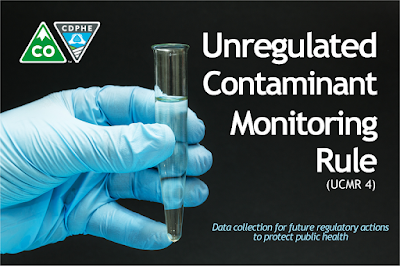A preliminary look at Colorado and national UCMR 4 sample results
 The EPA collects data on chemicals and substances that may be present in drinking water but are not currently covered by EPA drinking water regulations. This data is used for monitoring the occurrence of unregulated drinking water contaminants.
The EPA collects data on chemicals and substances that may be present in drinking water but are not currently covered by EPA drinking water regulations. This data is used for monitoring the occurrence of unregulated drinking water contaminants.Every five years, the EPA issues a list of new substances of concern which is the Unregulated Contaminant Monitoring Rule (UCMR). All systems serving over 10,000 and some others must monitor for these substances. The monitoring test results from these systems help the EPA determine whether to regulate these substances in the future. All sample results are available to the public on the EPA's UCMR webpage. Many of these substances can present acute, lifetime or cancer risks, and have health-based reference concentrations. UCMR 4 was published to the Federal Register on December 20, 2016, and covers 2017-2021.
Between 2018 and 2020, over 100 Colorado public water systems will complete this testing as part of UCMR 4. A listing of all UCMR 4 substances and their health-based reference concentrations is available on our compliance forms webpage.
Local results
The EPA started posting UCMR 4 sample results to their website in October 2018. Initial sample results from Colorado public water systems show detection of manganese, the brominated haloacetic acid groups, and 1-butanol. None of the results exceeded available health-based reference concentrations. There were no results for the cyanotoxin groups caused by harmful algal blooms.National results
Initial sample results show:- For the cyanotoxin groups, 0.8% of public water systems exceeded the health-based reference concentration of 0.3 µg/L for total mycrocystins. There were five detects for anatoxin-a and one detect for cylindrospermopsin which was below the health-based reference concentration.
- 1% of drinking water systems exceeded the health-based reference concentration of 300 µg/L for manganese.
- No systems exceeded a reference concentration for 10-4 cancer risk (1 in 10,000) for the pesticide, alcohol, and other semivolatile chemical groups.
- 5.4% of public water systems exceeded the regulated haloacetic acid (HAA5) concentration of 60 µg/L. HAA5 is the only regulated substance being monitored for as part of UCMR 4.
➽ David Dani, local assistance unit
